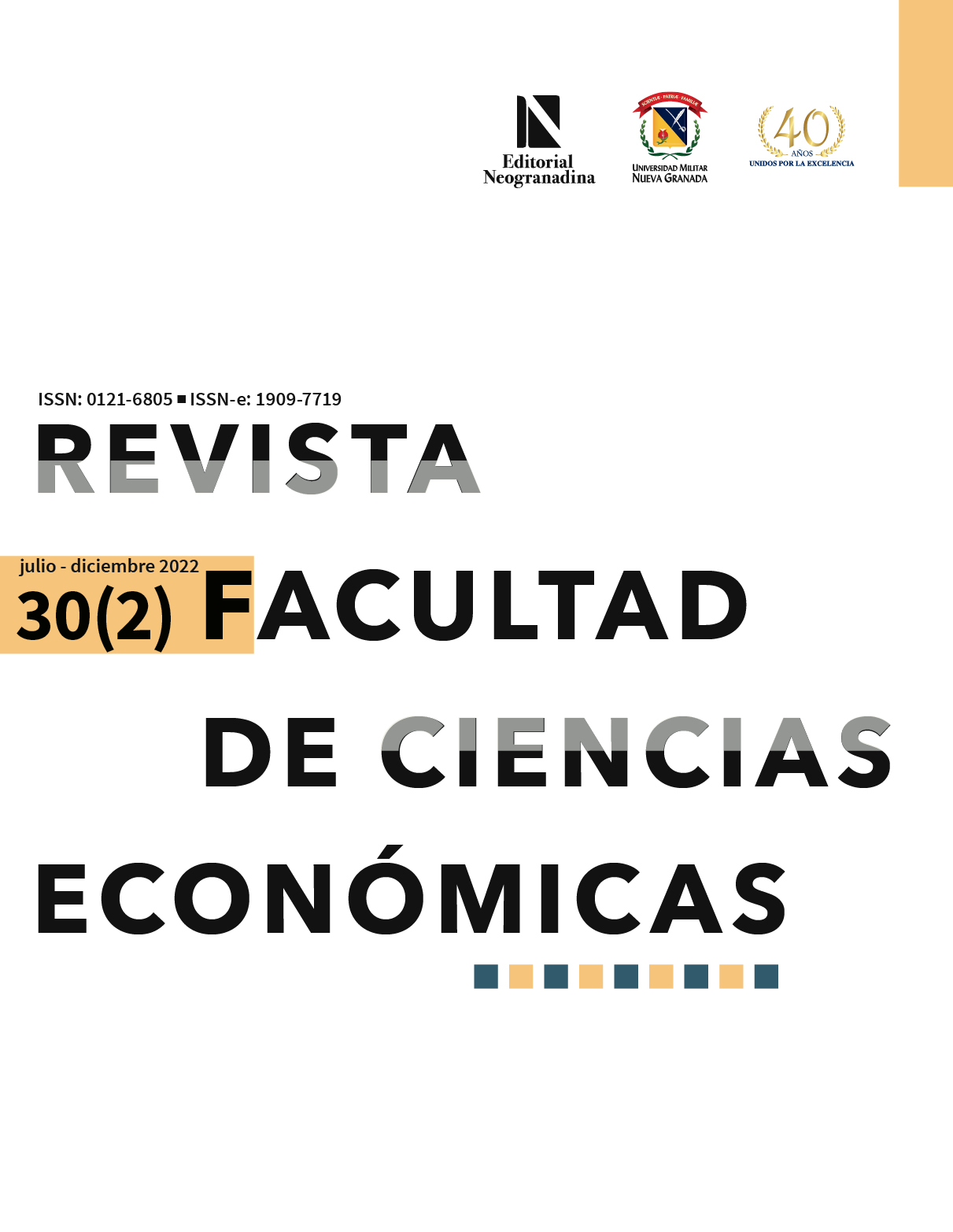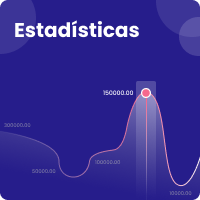Análisis de la eficiencia de centros comerciales, a través del análisis envolvente de datos
Resumen
Este documento tiene como objetivo presentar el cálculo de la eficiencia de centros comerciales a partir del modelo de análisis envolvente de datos (dea), el ranking de los centros comerciales más eficientes por medio del cálculo de la súper eficiencia con orientación al input y el comparativo en productividad entre 2017 y 2019, con el índice de Malmquist. Respecto a la metodología, se seleccionaron dieciocho centros comerciales de la ciudad de Bogotá, a cuyos datos pertinentes se aplicó el modelo dea, relacionado con el nivel de eficiencia y el índice de Malmquist, para medir los cambios en su productividad. Todos los establecimientos cuentan con ubicaciones comerciales, son reconocidos en el mercado, cuentan con una trayectoria superior a tres años y están distanciados geográficamente unos de otros. El desempeño de los centros comerciales en Colombia había sido medido hasta el momento solo a través de dos de los Key Performance Indicators (kpi) más utilizados en la literatura: el tráfico (número de visitas) y las ventas (Acecolombia, 2020); su valoración se había basado en la comparación de los resultados en estos kpi con los de un periodo anterior. Este estudio presenta el primer análisis para medir la eficiencia de la industria de centros comerciales en Colombia y una de las primeras aplicaciones del modelo dea para evaluar dicha eficiencia; sus principales conclusiones están relacionadas con la oportunidad que estos centros tienen para reducir la inversión en mercadeo y la cuota de administración, además de la modificación de la estrategia en cuanto a la inversión en la zona comercial.
Descargas
Referencias bibliográficas
Acecolombia. (2020). Tercer reporte de la industria de centros comerciales. https://acecolombia.org/acecolombia/sites/default/files/3er%20Reporte%20del%20impacto%20en%20la%20industria.pdf
Amirteimoori, A., y Khoshandam, L. (2011). A data envelopment analysis approach to supply chain efficiency. Advances in Decision Sciences, 2011, 1-8. https://doi.org/10.1155/2011/608324
An, Q., Chen, H., Wu, J., y Liang, L. (2015). Measuring slacks-based efficiency for commercial banks in China by using a two-stage DEA model with undesirable output. Annals of Operations Research, 235(1), 13-35. https://doi.org/10.1007/s10479-015-1987-1
Andersen, P., y Petersen, N. (1993). A procedure for ranking efficient units in data envelopment analysis. Management Science, 39, 1261–1264. https://doi.org/10.1287/mnsc.39.10.1261
Anselmsson, J. (2006). Sources of customer satisfaction with shopping malls: a comparative study of different customer segments. International Review of Retail, Distribution and Consumer Research, 16(1), 115–138. https://doi.org/10.1080/09593960500453641
Anselmsson, J. (2016). Effects of shopping centre re-investments and improvements on sales and visit growth. Journal of Retailing and Consumer Services, 32, 139–150. https://doi.org/10.1016/j.jretconser.2016.06.009
Avkiran, N. K. (2011). Association of DEA super-efficiency estimates with financial ratios: Investigating the case for Chinese banks. Omega, 39(3), 323–334. https://doi.org/10.1016/j.omega.2010.08.001
Banker, R. D., Charnes, A., y Cooper, W. W. (1984). Some models for estimating technical and scale inefficiencies in data envelopment analysis. Management Science, 30(9), 1078–1092. https://doi.org/10.1287/mnsc.30.9.1078
Barros, C. P. (2006). Efficiency measurement among hypermarkets and supermarkets and the identification of the efficiency drivers: A case study. International Journal of Retail and Distribution Management, 34(2), 135–154. https://doi.org/10.1108/09590550610649795
Barros, C. P., y Athanassiou, M. (2004). Efficiency in European seaports with DEA: Evidence from Greece and Portugal. Maritime Economics and Logistics, 6(2), 122–140. https://doi.org/10.1057/palgrave.mel.9100099
Barros, C. P., y Perrigot, R. (2008). Analysing technical and allocative efficiency in the French grocery retailing industry. International Review of Retail, Distribution and Consumer Research, 18(4), 361–380. https://doi.org/10.1080/09593960802299437
Berman, B., y Evans, J. (2004). Retail Management: A Strategic Approach. Pearson Education Inc.
Borgers, A., y Vosters, C. (2011). Assessing preferences for mega shopping centres: a conjoint measurement approach. Journal of Retailing and Consumer Services, 18(4), 322–332. https://doi.org/10.1016/j.jretconser.2011.02.006
Boyd, T., Docken, G., y Ruggiero, J. (2016). Outliers in data envelopment analysis. Journal of Centrum Cathedra, 9(2), 168–183. https://doi.org/10.1108/jcc-09-2016-0010
Calvo-Porral, C., y Lévy-Mangín, J. P. (2018). Pull factors of the shopping malls: an empirical study. International Journal of Retail and Distribution Management, 46(2), 110–124. https://doi.org/10.1108/IJRDM-02-2017-0027
Caves, D., Christensen, L., y Diewert, W. (1982). The economic theory of index numbers and the measurement of input, output, and productivity. Econometrica, 50(6), 1393–1414. https://doi.org/10.2307/1913388
Chang, H., Choy, H. L., Cooper, W. W., y Ruefli, T. W. (2009). Using Malmquist Indexes to measure changes in the productivity and efficiency of US accounting firms before and after the Sarbanes-Oxley Act. Omega, 37(5), 951–960. https://doi.org/10.1016/j.omega.2008.08.004
Chapman, L., y Sadd, D. (2014). Events as strategic marketing tools in shopping centers. Event Management, 18(3), 357–367. https://doi.org/10.3727/152599514X13989500765925
Charnes, A., Cooper, W. W., y Rodes, E. (1978). Measuring the efficiency of decision making units. European Journal of Operational Research, 2, 429–444.
Contreras, I. (2020). A review of the literature on DEA models under common set of weights. Journal of Modelling in Management, 15(4), 1277–1300. https://doi.org/10.1108/JM2-02-2019-0043
Cook, W. D., y Seiford, L. M. (2009). Data envelopment analysis (DEA) - Thirty years on. European Journal of Operational Research, 192(1), 1–17. https://doi.org/10.1016/j.ejor.2008.01.032
Cook, W. D., Hababou, M., y Liang, L. (2005). Financial Liberalization and Efficiency in Tunisian Baking Industry: DEA test. International Journal of Information and Decision Making, 4(3), 455–475.
Crawfort, M. (1986). The mall and the strip: from building type to urban form. Urban, 83, 34–41.
Damian, D. S., Curto, J. D., y Pinto, J. C. (2011). The impact of anchor stores on the performance of shopping centres: The case of Sonae Sierra. International Journal of Retail and Distribution Management, 39(6), 456–475. https://doi.org/10.1108/09590551111137994
Davidovic, M., Uzelac, O., y Zelenovic, V. (2019). Efficiency dynamics of the Croatian banking industry: DEA investigation. Economic Research-Ekonomska Istrazivanja, 32(1), 33–49. https://doi.org/10.1080/1331677X.2018.1545596
De Jorge Moreno, J. (2010). Productivity growth of European retailers: A benchmarking approach. Journal of Economic Studies, 37(3), 288–313. https://doi.org/10.1108/01443581011061285
De Mateo, F., Coelli, T., y O’Donnell, C. (2006). Optimal paths and costs of adjustment in dynamic DEA models: With application to Chilean department stores. Annals of Operations Research, 145(1), 211–227. https://doi.org/10.1007/s10479-006-0034-7
Dlamini, S. y Cloete, C. (2021). The influence of tenant diversity on the performance of shopping centres. African Journal of Business and Economic Research, 16(2), 161–183. https://doi.org/10.31920/1750-4562/2021/v16n2a8
Donthu, N., y Yoo, B. (1998). Retail productivity assessment using data envelopment analysis. Journal of Retailing, 74(1), 89–105. https://doi.org/10.1016/s0022-4359(99)80089-x
Emrouznejad, A., y Yang, G. (2018). A survey and analysis of the first 40 years of scholarly literature in DEA: 1978–2016. Socio-Economic Planning Sciences, 61, 4–8. https://doi.org/10.1016/j.seps.2017.01.008
Färe, R., Grosskopf, S., y Margaritis, D. (2011). Malmquist productivity indexes and DEA. International Series in Operations Research and Management Science, 164, 127–149. https://doi.org/10.1007/978-1-4419-6151-8_5
Farrell, M. (1957). The measurement of productive efficiency. Journal of the Royal Statistical Society, Series A. (3), 253–281. https://doi.org/10.2307/2343100
Frasquet, M., Gil, I., y Molla, A. (2001). Shopping-centre selection modeling: a segmentation approach. The International Review of Retail, Distribution and Consumer Research, 11(1), 23–38. https://doi.org/10.1080/09593960122279
Guy, C. (1994). The Retail Development Process: Location, Property and Planning. Routledge.
Halkos, G., Tzeremes, N., y Stavros, K. (2011). The use of Supply Chain DEA Models in Operations Management: A Survey. MUNICH Personal RePEc Archive, 31846, 0–33.
Hänninen, M., y Paavola, L. (2021). Managing transformations in retail agglomerations: Case Itis shopping center. Journal of Retailing and Consumer Services, 59. https://doi.org/10.1016/j.jretconser.2020.102370
Holod, D., y Lewis, H. F. (2011). Resolving the deposit dilemma: A new DEA bank efficiency model. Journal of Banking and Finance, 35(11), 2801–2810. https://doi.org/10.1016/j.jbankfin.2011.03.007
Hsiao, J. M., Sung, C. W. y Kralj, D. (2013). The measurement of operating efficiency: A case study of Fong Shan Tourism Plaza. WSEAS Transactions on Business and Economics, 7(29), 2836-2844. https://doi.org/10.5897/ajbm2013.7050
Ibrahim, I., Bon, A. T., Nawawi, A. H., Safian, E. E. M., e Ibrahim, I. (2018). Shopping centre classification scheme: A comparison of international case studies. Proceedings of the International Conference on Industrial Engineering and Operations Management, 2018-March, 3131–3142. http://ieomsociety.org/ieom2018/papers/716.pdf
Ingene, C. A. (2014). Retail evolution. Journal of Historical Research in Marketing, 34(1), 279–299.
Joseph, E. (2019). Mall performance: Corporate, retail, restaurants and e-commerce effects. International Journal of Financial Research, 10(2), 1–15. https://doi.org/10.5430/ijfr.v10n2p1
Kashyap, A. K., y Kumar, A. (2019). Understanding customer perceived mall values: A confirmatory factor analysis approach. International Journal of Customer Relationship Marketing and Management, 10(3), 21–34. https://doi.org/10.4018/IJCRMM.2019070102
Ke, Q., y Wang, W. (2016). The factors that determine shopping centre rent in Wuhan, China. Journal of Property Investment and Finance, 34(2), 172–185. https://doi.org/10.1108/JPIF-04-2015-0021
Keh, H. T., y Chu, S. (2003). Retail productivity and scale economies at firm level: a DEA approach. Omega, 31(2), 75–82. https://doi.org/10.1016/s0305-0483(02)00097-x
Kunc, J., Reichel, V., y Novotná, M. (2020). Modelling frequency of visits to the shopping centres as a part of consumer’s preferences: case study from the Czech Republic. International Journal of Retail and Distribution Management, 48(9), 985–1002. https://doi.org/10.1108/IJRDM-04-2019-0130
Makgopa, S. (2016). Determining consumers’ reasons for visiting shopping malls. Innovative Marketing, 12(2), 22–27. https://doi.org/10.21511/im.12(2).2016.03
Mall & Retail. (2020). Estos son los centros comerciales más poderosos: Mapa de los Centros Comerciales 2020 M&R. Mall & Retail. https://www.mallyretail.com/actualidad/mall-y-retail-boletin-329-noticia-1.
Malmquist, S. (1953). Index Numbers and Indifference Surfaces. Trabajos de Estadística, 4(2), 209-242. https://doi.org/10.1007/bf03006863
Noura, A. A., Hosseinzadeh Lotfi, F., Jahanshahloo, G. R., y Fanati, S. (2011). Super-efficiency in DEA by effectiveness of each unit in society. Applied Mathematics Letters, 24(5), 623–626. https://doi.org/10.1016/j.aml.2010.11.025
Palevičius, V., Burinskienė, M., Podvezko, V., Paliulis, G. M., Šarkienė, E., y Šaparauskas, J. (2016). Research on the demand for parking lots of shopping centres. E a M: Ekonomie a Management, 19(3), 173–194. https://doi.org/10.15240/tul/001/2016-3-012
Parsons, A. G., y Ballantine, P. W. (2004). Market dominance, promotions, and shopping mall group performance. International Journal of Retail y Distribution Management, 32(10), 458–463. https://doi.org/10.1108/09590550410558590
Ronghua, Y. U., y Quanyi, Y. E. (2011). Appraisal of China’s Urban Underground Shopping Malls Based on Data Envelopment Analysis Model. International Business and Management, 3(2), 141–146. https://doi.org/10.3968/j.ibm.1923842820110302.195
Santoso, D. S., Joewono, T. B., y Sunanto, S. (2018). Analysing mall attributes in defining the desire of consumers to stay. Journal of Facilities Management, 16(4), 396–412. https://doi.org/10.1108/JFM-04-2017-0020
Savelli, E. (2018). Experience Economy and the Management of Shopping Centers: The Role of Entertainment. En International Series in Advanced Management Studies (pp. 25-148). Springer International Publishing. https://doi.org/10.1007/978-3-319-77550-0_7
Šegota, A. (2008). Evaluating shops efficiency using data envelopment analysis: Categorical approach. Zbornik Radova Ekonomskog Fakultet Au Rijeci, 26(2), 325–343. https://hrcak.srce.hr/30576
Soheilirad, S., Govindan, K., Mardani, A., Zavadskas, E. K., Nilashi, M., y Zakuan, N. (2018). Application of data envelopment analysis models in supply chain management: a systematic review and meta-analysis. Annals of Operations Research, 271(2), 915–969. https://doi.org/10.1007/s10479-017-2605-1
Suárez-Vega, R., Gutiérrez-Acuna, J. L., y Rodríguez-Díaz, M. (2019). Using a productivity function based method to design a new shopping center. Journal of Retailing and Consumer Services, 51, 176–185. https://doi.org/10.1016/j.jretconser.2019.06.008
Teller, C., Wood, S., y Floh, A. (2016). Adaptive resilience and the competition between retail and service agglomeration formats: an international perspective. Journal of Marketing Management, 32(17–18), 1537–1561. https://doi.org/10.1080/0267257X.2016.1240705
Tokosh, J. (2018). You’re dead to me, but should you be? Using a retail database to classify American malls by occupancy and sales and an extended analysis of dead and dying malls. International Review of Retail, Distribution and Consumer Research, 28(5), 490–515. https://doi.org/10.1080/09593969.2018.1509801
Tsai, S. P. (2010). Shopping mall management and entertainment experience: across-regional investigation. Services Industry Journal, 30(3), 321–337. https://doi.org/10.1080/02642060802123376
Vyt, D., y Cliquet, G. (2017). Towards a fairer manager performance measure: a DEA application in the retail industry. International Review of Retail, Distribution and Consumer Research, 27(5), 450–467. https://doi.org/10.1080/09593969.2017.1383293
Wang, Y., y Xu, D. (2021). Research on the Business Model Innovation of Sisyphe Bookstore under background of New Retail [Proceedings]. 2nd International Conference on E-Commerce and Internet Technology, ECIT. https://doi.org/10.1109/ECIT52743.2021.00029
Warnaby, G., y Medway, D. (2018). Marketplace icons: shopping malls. Consumption Markets and Culture, 21(3), 275–282. https://doi.org/10.1080/10253866.2016.1231749
Wilson, P. (1995). Detecting influential observations in data envelopment analysis. Journal of Productivity Analysis, 6(1), 27–45. https://doi.org/10.1007/bf01073493
Xavier, J. M., Moutinho, V. M., y Moreira, A. C. (2015). Efficiency and convergence analysis in a women’s clothing retail store chain: Evidence from Portugal. International Journal of Retail and Distribution Management, 43(9), 796–814. https://doi.org/10.1108/IJRDM-06-2014-0077
Yu, L. (2006). A Systematic Approach to Location Selection for Shopping Mall Projects. [Tesis de doctorado]. The Hong Kong Polytechnic University.
Yu, W., y Ramanathan, R. (2009). An assessment of operational efficiency of retail firms in China. Journal of Retailing and Consumer Services, 16(2), 109–122. https://doi.org/10.1016/j.jretconser.2008.11.009

Derechos de autor 2022 Revista Facultad de Ciencias Económicas

Esta obra está bajo una licencia internacional Creative Commons Atribución-NoComercial-SinDerivadas 4.0.











